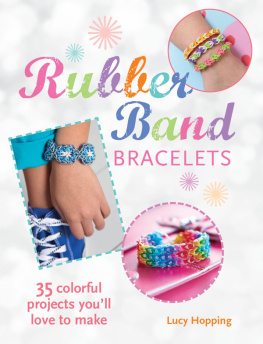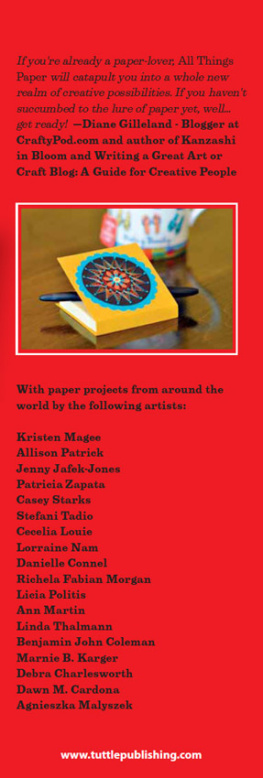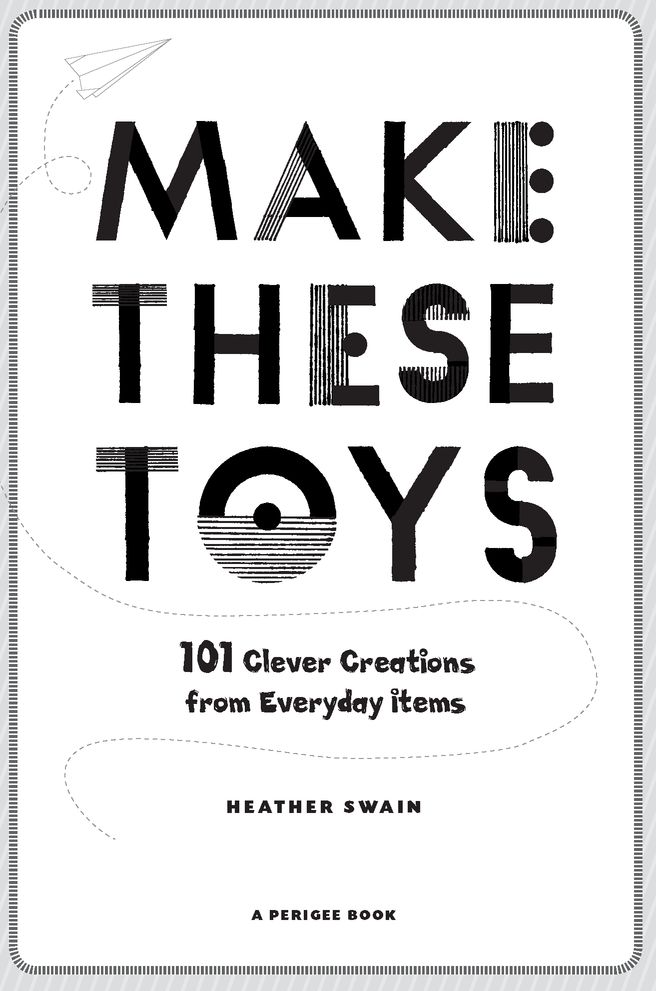Table of Contents
For Clementine and Graham
Acknowledgments
I could no more write this book without the following people in my life than I could make a mini-marshmallow popper without paper cups and balloons:
Barbara Swaincreative, resourceful mom who taught me the art of playing
Richard Swainsupportive father who loves to save a buck
Dan Vonneguthusband who doesnt mind when I make a mess because he believes (even before I do) that Ill make something interesting
Clementine and Grahamkids who fill my day with wonder and are the inspiration for everything I make
Lucinda Brownformer fluids gal whose engineering background was indispensable to the creation of the windup toys
Stephanie Kip-Rostansuperagent who helped form the idea for this book
Monika Vermasuperagents right-hand gal who keeps track of all the details
Meg Ledereditor extraordinaire who made this book possible
Perigee staffthe people who turned the idea into reality
Becky, Em, and LJmy playmates and personal cheerleaders who keep me sane when all my screws have fallen under the table and I cant find the glue stick
introduction
KIDS TODAY CAN get virtually any plaything their little hearts desire by jumping online (either virtually via the Internet or by going old-school and standing in line at the local toy store). And yet, years ago, before mega toy and standing in line at the local toy store). Andyet, years ago, before mega toy stores and Internet shopping, kids found plenty of ways to entertain themselves. Children have been playing with rag dolls, slingshots, sewing cards, and wooden hoops with sticks since homesteaders parked their Conestoga wagons on the prairies. Most of these playthings were made by either the kids themselves or the grown-ups who loved them. Even though we dont have to make toys for kids anymore, there are still plenty of good reasons to make toys at home.
1. Making Toys Saves Money
As with most things in life, if you make your fun rather than buy it, youll save a few bucks. Im not talking whittling wooden heirlooms from trees you fell on the back forty or building elaborate motorized models from an old radio you took apart (neither of which Im savvy enough or patient enough to do). My family has a playroom filled with toys, most of which come from stores because either they were gifts or we decided they were worth the money. In this book, Im talking mostly about replacing that cheap mass-manufactured junk (the kind that circulates through the toy store shelves, into our homes, and straight to the landfill after it breaks twenty-four seconds after use) with stuff you can make yourself because fun doesnt have to come in a box. Sometimes fun is a box. And boxes are cheap.
2. Making Toys Conserves Resources
Maybe you dont mind the couple hundred bucks you might save if you made propeller boats out of milk cartons and dolls out of old T-shirts. Then how about that tried-and-true recycling motto: Reduce, Reuse, Recycle? You probably already have everything lying around your house that I use in this book and most of it you were going to chuck anyway. So why not make something out of it first, then toss it after the kids have had some fun? At the end of the day, the more toys you make, the less plastic crapola ends up buried in the ground somewhere.
3. Making Toys Means Fewer Toxins in Your Home
Maybe you figure the trash can full of things youd throw away wouldnt make that big of a difference to the earth when were all driving SUVs and stinking up the environment anyway. Fair enough, but how about all the reports of toxins in toys, from lead in the paint to BPA in the plastic to tiny magnets that kids might swallow? Its enough to make me want to give my kids a wooden hoop and corncob doll to play with. So, if the safety of toys concerns you, then making toys out of food cartons and fabric, poster board and drinking straws might alleviate some of your worry.
4. Making Toys Is Fun
And if none of that resonates, then how about this: Half the fun of playing with homemade toys is making them. If youre already a crafty person or youd like to be more of one or if you want to raise kids to be creative and resourceful, then making toys is a simple, inexpensive, safe, and fun place to start. Understanding how to build the things we play with opens doors for imagination and innovation and ultimately teaches us how to entertain ourselves without always spending money.
For me theres one reason that trumps all those others and thats how my kids respond to homemade toys. Ive always been pretty crafty around the house, but once I started working on this book and making most of the things my kids play with, an interesting thing happened. Now, instead of asking me to buy them toys, first they ask me if I can make them something. And sometimes when theyre bored, they skip the whining about how they dont have any toys and instead they make something themselves. The first toy my five-year-old daughter made warmed my soul (warning: I will now brag about my child). She drew a picture of me on a wooden craft stick, then drew a picture of herself on a wooden hinged clothespin. She attached the clothespin to the top of the craft stick and said, See, its me riding on your shoulders. Now Im going to make Daddy. I swooned with delight.
So, I like reasons 1, 2, and 3, but to be honest, I consider them merely perks to number 4. And all four reasons point to the biggest one of all: Making toys makes kids happy, which is what playing should be all about.
How to Use This Book
YOUVE GOT YOUR crafts: flowers pressed in waxed paper, decoupage vases, handprint turkeys, pinecone snowmen.
Youve got your toys: plastic-headed dolls that squeal and pee, tiny metal cars with rubber tires, battery-powered bubble blowers, giant plastic playhouses with microwaves and cell phone replicas.
And then youve got your crafty toys.
In my book, a craft is something you make and then it either sits on a shelf for your handiwork to be admired or it has some practical application, like a crocheted poncho. A toy, on the other hand, is something you play with. The process of making it is the first step, one that is usually farmed out to a manufacturer somewhere, unless you get crafty and circumvent the system by making your own toys out of stuff around your house.
This book is set up like a craft book. Its organized by materialscardboard tubes, balloons, spools, and the like. Each project lists all the materials you will need, followed by step-by-step written instructions and simple line drawings to help you understand the process. When youre done making the project youll end up with something you and your kids can play with for a while.
Some of the projects are longtime favorites among people who make toys at home, such as kaleidoscopes, clothespin people, and sock babies. Others are reinterpretations of toys you might see in old catalogs or early-twentieth-century toy books, such as the zip-line balloon racer, the stacking box face puzzle, and the shoe box baby carriage. Hopefully, most of what youll find here will be new takes or fresh ideas for homemade toys, though Id never claim to be the only one whos ever made these things. If ideas like evolution and electricity were simultaneously discovered by different people, Im certain someone else in the history of the world has figured out how to make a version of my mini-marshmallow popper.








